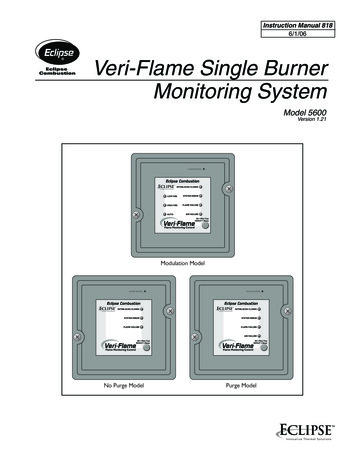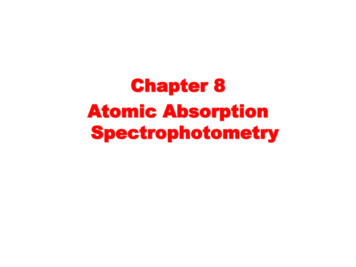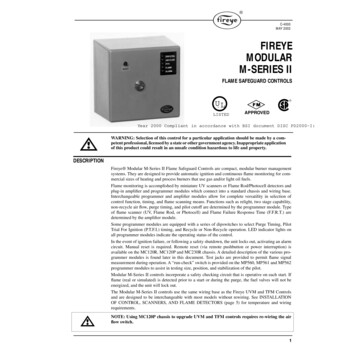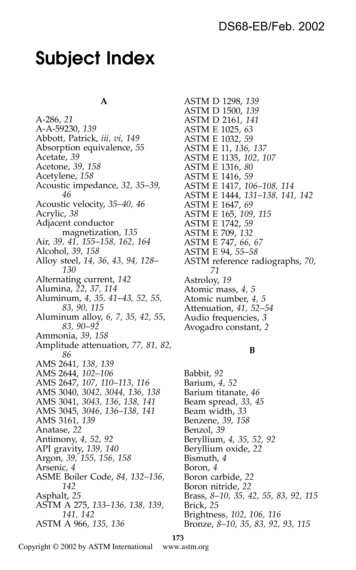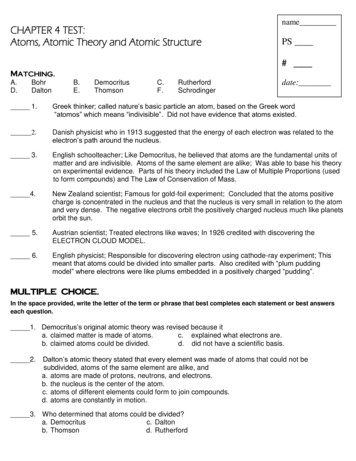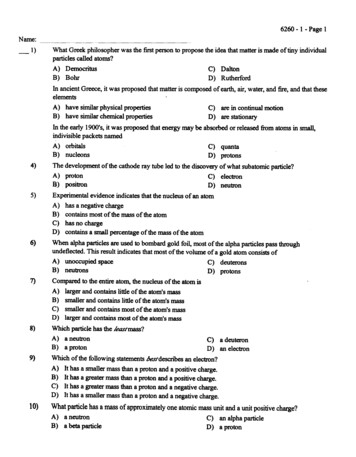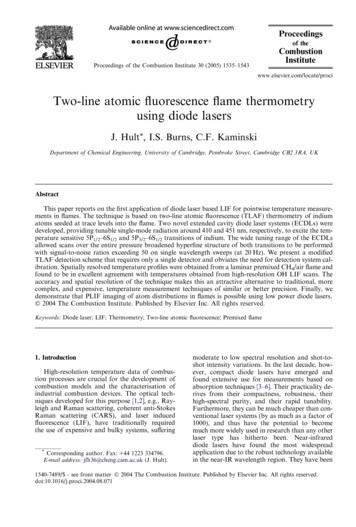
Transcription
Proceedingsof theCombustionInstituteProceedings of the Combustion Institute 30 (2005) 1535–1543www.elsevier.com/locate/prociTwo-line atomic fluorescence flame thermometryusing diode lasersJ. Hult*, I.S. Burns, C.F. KaminskiDepartment of Chemical Engineering, University of Cambridge, Pembroke Street, Cambridge CB2 3RA, UKAbstractThis paper reports on the first application of diode laser based LIF for pointwise temperature measurements in flames. The technique is based on two-line atomic fluorescence (TLAF) thermometry of indiumatoms seeded at trace levels into the flame. Two novel extended cavity diode laser systems (ECDLs) weredeveloped, providing tunable single-mode radiation around 410 and 451 nm, respectively, to excite the temperature sensitive 5P1/2–6S1/2 and 5P3/2–6S1/2 transitions of indium. The wide tuning range of the ECDLsallowed scans over the entire pressure broadened hyperfine structure of both transitions to be performedwith signal-to-noise ratios exceeding 50 on single wavelength sweeps (at 20 Hz). We present a modifiedTLAF detection scheme that requires only a single detector and obviates the need for detection system calibration. Spatially resolved temperature profiles were obtained from a laminar premixed CH4/air flame andfound to be in excellent agreement with temperatures obtained from high-resolution OH LIF scans. Theaccuracy and spatial resolution of the technique makes this an attractive alternative to traditional, morecomplex, and expensive, temperature measurement techniques of similar or better precision. Finally, wedemonstrate that PLIF imaging of atom distributions in flames is possible using low power diode lasers. 2004 The Combustion Institute. Published by Elsevier Inc. All rights reserved.Keywords: Diode laser; LIF; Thermometry; Two-line atomic fluorescence; Premixed flame1. IntroductionHigh-resolution temperature data of combustion processes are crucial for the development ofcombustion models and the characterisation ofindustrial combustion devices. The optical techniques developed for this purpose [1,2], e.g., Rayleigh and Raman scattering, coherent anti-StokesRaman scattering (CARS), and laser inducedfluorescence (LIF), have traditionally requiredthe use of expensive and bulky systems, suffering*Corresponding author. Fax: 44 1223 334796.E-mail address: jfh36@cheng.cam.ac.uk (J. Hult).moderate to low spectral resolution and shot-toshot intensity variations. In the last decade, however, compact diode lasers have emerged andfound extensive use for measurements based onabsorption techniques [3–6]. Their practicality derives from their compactness, robustness, theirhigh-spectral purity, and their rapid tunability.Furthermore, they can be much cheaper than conventional laser systems (by as much as a factor of1000), and thus have the potential to becomemuch more widely used in research than any otherlaser type has hitherto been. Near-infrareddiode lasers have found the most widespreadapplication due to the robust technology availablein the near-IR wavelength region. They have been1540-7489/ - see front matter 2004 The Combustion Institute. Published by Elsevier Inc. All rights reserved.doi:10.1016/j.proci.2004.08.071
1536J. Hult et al. / Proceedings of the Combustion Institute 30 (2005) 1535–1543successfully used for absorption based flame temperature measurements, probing reactants such asO2 [7], fuels such as C2H4 [8], product species suchas H2O [5,6], or seeded species such as caesium [9].However, absorption based techniques sufferfrom poor spatial resolution because they areline-of-sight techniques, and this severely limitstheir use as temperature sensors for non-homogeneous or turbulent flows. Spatial averaging overregions of high and low temperatures results indistorted population distributions, from whichaccurate temperature information cannot be extracted unless a priori knowledge of the flow composition is available, which is rarely the case.Recently, diode lasers operating in the blue spectral region have become available [10–12], andare capable of direct excitation of electronic transitions of flame species. We have recently shownthat such lasers can be successfully used forhigh-resolution LIF spectroscopy in flames [13].Here, we report on the development of a new,high-precision flame temperature measurementtechnique based on two-line atomic fluorescence(TLAF) of atomic indium.The paper is organised as follows: in Section 2,we review concepts of TLAF and proceed to present our TLAF scheme, which is much less calibration intensive than the one usually employed. InSection 3, the experimental details are presented.High-resolution scans of the indium hyperfinestructure in the 5P–6S system are presented in Section 4. Spatially resolved temperature profilesfrom a laminar Bunsen flame are presented andcompared to temperatures obtained from highresolution OH LIF scans. Finally, we show PLIFimages of indium distributions obtained withdiode lasers and compare them to OH PLIFimages. Conclusions and a future outlook are given in Section 5.2. TheoryIn TLAF, the population distribution of twotemperature sensitive electronic states of atomsseeded into the flame is probed by measuring theStokes and anti-Stokes direct-line fluorescencefrom a common upper state. Temperatures are thenevaluated from the ratio of the corresponding fluorescence signals [14–17]. TLAF is an attractivemeasurement technique because it is not affectedby molecular collisions: since excitation is to thesame upper state for both fluorescence processes,quenching rates cancel out in the expression fortemperature. Furthermore, atomic tracers havemuch higher transition strengths than molecularspecies, and thus lower excitation powers may beused. Indium is particularly suitable as a tracerfor TLAF, because the spin–orbit splitting in the5P ground state of indium leads to an energy spacing that is ideally matched to kT in typical combus-tion environments (1000–3000 K), leading to veryhigh-temperature sensitivities [18,19]. Early demonstrations of the technique in flames employedlamps for excitation [15,18,20]. High-repetitionrate pointwise temperature measurements in flameshave been reported, employing two argon ion laserpumped continuous-wave dye lasers [17,21]. Ourgroup has developed the method into a 2D thermometry approach [22] employing pulsed lasers,and reported the first application of the techniqueto map out cycle resolved 2D temperature profilesin a running SI prototype car engine [18,23].Previous applications of indium TLAF wereperformed using two lasers and two detectors, asshown in the scheme depicted in Fig. 1A. In thediagram, the 52P1/2, 52P3/2, and the 62S1/2 levelsare represented by numbers 1, 2, and 3, respectively. Initially, the 1 fi 3 transition is pumpedat k31, and the filtered fluorescence F32 is detected.Then, the 2 fi 3 transition is pumped at k32, andF31 is detected using a second filtered detector.From the ratio of the two fluorescence signals,the temperature, T, can then be determined usingEq. (1). This equation can be derived by combining the rate equations with the Boltzmann population equation [14,17]T ¼ln F 32 I m13F 31 I m23 DE k :þ 4 ln kk3231 þ ln ðC 1 Þð1ÞHere, I m23 and I m13 are the laser irradiances at k32and k31, respectively, DE is the energy separationbetween levels 1 and 2, and k is BoltzmannÕs constant. Note that no quenching rates appear in Eq.(1). Furthermore, due to the symmetry of the excitation and detection scheme, transition strengthsalso cancel out. C1 is a non-dimensional calibration constant, which is determined experimentallyand accounts for the varying efficiencies of the twodetectors, transmission characteristics of filters,corrections for relative laser power measurements,and, in the case of multi-mode laser sources (notapplicable here), the spectral overlap betweenthe laser profile and the atomic transition. Thecalibration of relative detection efficiencies is usually the largest source of systematic error.In this study, however, a different scheme isemployed, using only a single detector, as shownin Fig. 1B. Excitation from level 1 to level 3 is stillfollowed by detection of 3 fi 2 fluorescence, denoted here by Fa. However, 2 fi 3 excitation isFig. 1. (A) Conventional TLAF scheme and (B)modified TLAF scheme used in this study.
J. Hult et al. / Proceedings of the Combustion Institute 30 (2005) 1535–1543now followed by resonance fluorescence detection,Fb. This has the advantage that only one detectoris needed, since both signals are now detected atk32. Of course, the technique would also work ifone detects resonance fluorescence in the 3 fi 1transition instead [16], but there are several reasons why we prefer the former: the oscillatorstrength of the 3 fi 2 transition at 451 nm isnearly twice as strong as the 3 fi 1 transition(A32 1.02 · 108 s 1, A31 0.56 · 108 s 1). Furthermore, lower flame emission is present at451 nm, and there is less fluorescence trappingfor the signal at k32 due to the lower populationof state 2 compared to that of state 1. Our schemeobviates the need for calibration of differences indetection efficiencies, which hampers the previousapproach. The resulting expression for temperature is now found to be:T ¼ln F a Im13F b Im23 DE k :k32þ 3 ln k31 þ ln AA3231 þ ln ðC 2 Þð2ÞA disadvantage compared with the previous approach is that the Einstein coefficients, A31 andA32, now appear explicitly and need to be known.In this scheme, the experimental calibration constant C2 includes only small corrections, for example for the calibration of the laser power detectorefficiencies at k31 and k32, which can be measured.It is worth noting that, since resonance fluorescence is observed for Fb, our technique is applicable only in open flames with low particulateloading.3. ExperimentTwo novel widely tunable extended cavitydiode lasers operating around 410 and 451 nm1537were designed, which are described in [13,24].Fabry–Perot GaN laser diodes (Nichia), withoutanti-reflection coatings, were mounted in Littrowcavities to achieve tunable single-mode radiation[25]. Each cavity consisted of the diode, a collimating aspheric lens, and a holographic1800 lines/mm grating attached to a piezo-actuated kinematic mount [24,26]. The injection current and temperature of the diodes werecontrolled by standard laser driver units (Tektronix, LDC8002 and TED 8020). The outputpowers of the 410 and 451 nm ECDLs were 3.2and 1.0 mW, respectively. By simultaneous tuningof diode current and piezo voltage, mode-hop freetuning ranges exceeding 90 GHz were achieved, atscanning rates of 20 Hz.The experimental set-up for TLAF thermometry is illustrated in Fig. 2. The 410 and 451 nmbeams were overlapped and combined using a dichroic mirror and focused using an f 300 mmlens to a beam diameter of around 100 lm. TheLIF signal was imaged at f# 2.4 through a pinhole (d 150 lm) onto a photomultiplier tube(Hamamatsu, R3788), resulting in a probe volumeof around 0.1 · 0.1 · 0.15 mm3. An interferencefilter centred around 451.1 nm (CVI, Dk 3 nm)was used to suppress flame emission. The laserpowers were continuously recorded by monitoringreflections from quartz plates using photodiodes.The wavelength scans of the two lasers were monitored using a solid low finesse quartz etalon(FSR 3.1 GHz) in transmission mode. Laserpowers were referenced using a calibrated laserpower meter, inserted after the focusing lens. Inthe interaction region, the power in the 451 nmbeam was 0.4 mW. The power in the 410 nm beamwas attenuated to 0.2 mW at the same location, inorder to achieve fluorescence signals of similarintensities for the two transitions. The saturationirradiances of both transitions were theoreticallyestimated to ensure that the experiments wereFig. 2. Schematic illustration of experimental set-up used (ECDL, extended cavity diode laser; PD, photo diode; FP,Fabry–Perot etalon; IF, interference filter; and PMT, photomultiplier tube).
1538J. Hult et al. / Proceedings of the Combustion Institute 30 (2005) 1535–1543performed in the linear excitation regime. The calculation was done for a three-level system [27] andthe effects of collisional quenching and pressurebroadening at the experimental conditions wereaccounted for. For both excitation wavelengths,irradiances were found to be below saturation limits. The linear proportionality between the laserpower and fluorescence signal strength was alsoexperimentally confirmed for both transitionsusing a variable beam attenuator. The ECDLswere controlled and synchronised using a digitalfunction generator. The LIF signal, laser powersignals, and the etalon trace were all digitised bya 16 bit data acquisition card (National Instruments PCI-6014).The spectra were divided by the laser powerand averages of 200 spectra were used for the evaluation of temperatures. Theoretical spectra werefitted to the averaged spectra using a non-linearleast squares fitting routine. The fitted spectrawere integrated to yield F a I m13 and F b I m23 , whichwere then used to evaluate temperatures according to Eq. (2).An axis-symmetric premixed laminar CH4/airBunsen flame (/ P 1) stabilised on a translatableburner with a diameter of 10 mm was used for thisstudy. A pneumatic nebuliser was used to seed theairflow with a dilute solution of InCl3 (10 2 mol/L) in distilled water (seeding rate: 2.5 ml/h). Atthis level of seeding, no direct absorption of the laser beams by indium atoms was detected by aphotodiode after a single pass of the laser beamthrough the flame when scanning over either ofthe two transitions.In a separate experiment, the output from the410 nm ECDL was used for planar laser inducedfluorescence measurements (PLIF) of the indiumdistribution in the laminar flame. For this purpose, the laser wavelength was fixed to the centre peak of the 52P1/2 fi 62S1/2 transition. Thelaser beam was expanded to a sheet with across-section of 15 · 0.1 mm2. The PLIF signalwas detected using a digital video cameraequipped with a 451 nm interference filter. Exposure times of individual frames corresponded to8 ms. Laser sheet inhomogeneities were compensated for by recording fluorescence from dilutedye solutions.The TLAF temperatures were validated by OHexcitation scans performed in the same burner.Here, the frequency doubled output from aNd:YAG laser pumped dye laser was employed.The laser wavelength was scanned from 281.5 to283.2 nm to excite rotational lines with0.5 6 J 6 15.5 in the (0, 1) vibrational band ofthe A2R ‹ X2P system. OH fluorescence signalsfrom the (0, 0) and (1, 1) bands were collected by aPMT filtered with a UG 11 and a WG305 filter.OH LIF spectra were simulated and fitted to theexperimental spectra using a weighed non-linearleast squares fitting routine, using the programdescribed in [28]. The program takes full accountof rotational line dependence of the transition moment, fluorescence quantum yield (including effects of quenching and rotational energytransfer), and collisional broadening.4. ResultsThe continuous single-mode tuning range ofthe ECDL systems allowed scanning of the laserwavelength over the entire width of both indiumtransitions, as shown in Fig. 3. The 52P1/2 fi62S1/2 transition at 410 nm consists of four hyperfine components, the positions and strengths ofwhich are indicated in Fig. 3A. Figure 3 shows anaverage spectrum of 200 single scan spectra, a singlescan spectrum obtained in 50 ms, and a theoreticalfit to the average spectrum. The theoretical spectrum is the best non-linear least squares fit ofthe experimental spectrum with position, intensityscaling factor, background offset, and Voigtbroadening coefficient as floating parameters. Relative hyperfine peak separations were taken fromthe literature [29], and intensities were calculatedfrom the respective Clebsch–Gordan coefficients[30].The fitted Voigt profiles yield a pressure broadening component of around 6.6 GHz, assuming aa Doppler broadening component of around2.2 GHz corresponding to a temperature of2000 K. The pressure broadening coefficient is ingood agreement with that expected for N2 dominated collisional broadening at this temperatureand pressure [31]. Note that the total width ofthe 52P1/2 fi 62S1/2 transition is observed to bearound 30 GHz, which is considerably wider thanwhat has previously been assumed (2 GHz [17])and used in TLAF measurements. The observedwidth of this transition is thus comparable to oreven larger than the line width of conventionaldye laser systems. Effects of the temperaturedependence of the spectral overlap between the laser profile and the transition line width musttherefore be taken into consideration whendesigning such experiments. In the present technique, this is avoided since the it is possible toscan over the entire transition system at a muchhigher resolution ( 10 MHz laser linewidth). Signal-to-noise ratios exceeding 50 were obtainedeven on single scan spectrum, demonstrating thepotential of the technique for dynamic measurements. Note that the fluctuations observed onthe single scan spectrum are mainly due to localfluctuations in the indium concentrations, whichare observed to be largest close to the flame front.It should also be noted that the apparently highernoise levels observed on the right-hand side of thesingle scan spectrum are a normalisation artefactbecause laser powers diminished towards the endof the scan.
J. Hult et al. / Proceedings of the Combustion Institute 30 (2005) 1535–15431539Fig. 3. Indium LIF spectra of: (A) the 52P1/2 fi 62S1/2 indium transition near 410 nm, and, (B) of the 52P3/2 fi 62S1/2transition near 451 nm. Single scan spectrum is shown offset from the averaged spectra to improve clarity. Theoreticalfits, residuals, and positions and relative strengths of individual hyperfine peaks are also shown. The insert shows detailsof the transitions involved.Figure 3B shows the corresponding LIF excitation spectrum of the 52P3/2 fi 62S1/2 transition near451 nm. This consists of six closely spaced hyperfine transitions, as indicated. A pressure broadening coefficient of 5.8 GHz was measured here,which is smaller than for the 52P1/2 fi 62S1/2 transition discussed earlier, but this is consistent with previous findings for other group III metals [32]. Notethat background levels in the fit were close to zero,even for this resonance fluorescence spectrum.Figure 4 shows vertical profiles of the 410 and451 nm fluorescence signals along the centre axisof the flame. Data points correspond to the integrated fluorescence signal from 200 spectra, normalised by the laser power. At heights between15.5 and 16 mm significant increases in the indiumLIF signals are observed, as the neutral indiumatoms are generated close to the flame front.The fluorescence signals then decrease graduallywith increasing height, due to the oxidisation ofFig. 4. Temperature and TLAF signals along a verticalaxis through the centre of the flame. A temperaturedatum obtained from an OH excitation scan is alsoshown.indium. Error bars shown correspond to the standard deviation of the integrated fluorescence powers obtained from single scans. Observed signal
1540J. Hult et al. / Proceedings of the Combustion Institute 30 (2005) 1535–1543variations are thought to stem from dynamicchanges in neutral indium formation. This is substantiated by the fact that error bars are largestnear the tip of the flame where neutral indiumproduction rates are strongly affected by minuteflame flicker.The temperature profile, also shown in Fig. 4,was directly evaluated from averaged fluorescencepowers using Eq. (2). The excellent spatial resolution demonstrates the superiority of TLAF overconventional line-of-sight absorption techniquesto perform temperature measurement in spatiallyinhomogeneous combustion environments. Asteep rise in temperature is seen near the flamefront, with temperature staying nearly constantin the post-flame region, in agreement with previous studies of CH4/air Bunsen flames [33]. Temperatures in the post-combustion region are seento slightly fluctuate from one measurement pointto the next (around 2.5%). This scatter is a consequence of both minor drifts in local indium concentration and small flame movements due tocurrents of ambient air and flow speed variations.The largest systematic error in our temperaturemeasurement arises from the calibration of laserpower meters. We conservatively estimate this tobe around 10% in our case, which would introduce a systematic uncertainty of 7% or 130 K at2000 K. Further systematic errors stem from theuncertainty in reported A coefficients of the twoindium transitions, uncertainties in the frequencycalibration of laser scans, detector non-linearities,and background flame emission, but these are allmuch less significant in the present case. The errorbar shown at h 25 mm reflects the estimated total systematic uncertainty.A reference temperature measurement, indicated by a grey circle, was made at h 18.5 mmby performing an OH excitation scan. Figure 5shows the corresponding excitation scan, togetherwith the best fit simulated OH spectrum, giving atemperature of 2049 110 K (for a detailed discussion of uncertainties associated with the current procedures see [28], in the present case it isa combination of both flame fluctuations and fitting accuracy). As seen, the agreement betweenTLAF and OH measurements is excellent. In principle, such independent measurement techniquesFig. 5. OH excitation scan recorded at h 18.5 mm.The fitted spectrum corresponds to a temperature of2049 110 K.can be used to narrow down the systematic errormentioned in the previous paragraph. However,the small errors involved are a challenge evenfor the most accurate reported measurement techniques. For well-established temperature techniques, for example CARS, Raman or Rayleighscattering accuracies as low as 1–2%, 2%, and1%, respectively, have been reported in laminarflames [1,34]. There is no reason why the presenttechnique should not achieve similar or betteraccuracies, however, a careful calibration of thelaser power meters at the respective excitationwavelengths would then be required.In Fig. 6, a horizontal TLAF temperature profile is shown, obtained at a height of 10 mm abovethe burner. Again a steep increase in the indiumsignal is observed as the flame front is crossed,although the drop in signal is not as drastic asin the corresponding vertical profile in Fig. 4.The temperature increase at the flame front isclearly captured, the maximum temperature isslightly lower along this profile compared to themaximum temperature of the vertical profilethrough the upper part of the flame, which is inagreement with previous findings [33].Figure 7A shows a PLIF image of the indiumdistribution in the flame and Fig. 7B shows a corresponding OH PLIF image (imaged regions:22 · 10 mm2). The left-hand side is a compositeimage of four indium PLIF measurements obtained at different flame heights with 410 nm excitation. The OH PLIF corresponds to excitation ofthe Q1(1) line (indicated in Fig. 5) at 281.9 nm.Several observations can be made by comparingthese two images. First note that excellent signal-to-noise ratios are obtained even with weakdiode laser excitation, which offers promise for afuture extension of the diode TLAF technique toa planar measurement technique. Second, thereis an observed anti-correlation between regionsof high-indium signals and high-OH signals. Thisis in correspondence with previous investigationsof similar flames [35], where indium concentrations were found to be low in regions where strongoxidation takes place.Fig. 6. Temperature and TLAF signals along a horizontal axis through the centre of the flame.
J. Hult et al. / Proceedings of the Combustion Institute 30 (2005) 1535–1543Fig. 7. PLIF image of: (A) indium distribution and (B)OH distribution from a laminar premixed CH4/airBunsen flame.5. ConclusionsThis paper reports on the development of a novel temperature measurement technique based ontwo-line atomic fluorescence (TLAF) measurements with blue diode lasers. To the authorsÕknowledge, this is the first application of diode lasers for LIF based temperature measurements.The technique probes the relative population oftwo electronic states in indium atoms, which wereseeded at trace levels to the flame. Two extendedcavity diode lasers (ECDLs) operating near 410and 451 nm were constructed. The ECDLs allowed rapid scanning of the entire pressure broadened hyperfine structure of the 52P1/2 fi 62S1/2and 52P3/2 fi 62S1/2 transitions. Their width wasmeasured to be 30 and 14 GHz, respectively,much larger than what had previously been reported in the literature.A modified version of the TLAF technique wasused, employing only a single detector and detection wavelength, obviating the need for a calibration of the signal collection system, which is thelargest contribution to uncertainties in conventional TLAF. Spatially resolved temperature profiles of a laminar flame were measured, andobtained temperatures agreed well with those obtained by independently performed OH LIF excitation scans. Finally, the potential of using diodelasers for PLIF imaging of atomic species was demonstrated. Two-dimensional diode TLAF measurements may become a possibility in the future.It has previously been reported that indiumTLAF has potential as a tool for measurementsin rich, sooting, flames where OH thermometry1541is not possible [22]. To apply TLAF in such systems, a two detector approach involving non-resonance fluorescence detection from each indiumtransition would be required to avoid interferencefrom scattered laser radiation. The calibrationconstant C1 in Eq. (1) required for such a measurement is efficiently obtained by first performinga measurement in a non-sooting flame using thesingle detector scheme described in the present paper followed by a measurement using the non-resonant, double detector scheme. Note that thisdoes not require any modifications to the opticalset-up.Currently, we are modifying our present TLAFset-up to allow high-repetition rate measurementsto be performed, which would enable the probingof turbulent flames. To do this, the diodes will nolonger be operated in scanning mode because theECDL wavelength tuning is not rapid enough. Instead, the laser lines will be locked to frequenciesnear the peaks of respective indium transitions. Arapid laser switching scheme similar to what hasbeen outlined by Dec and Keller [17] could beenvisaged to achieve kHz repetition rates. Theblue diode laser TLAF technique offers excitingpotential for a wide range of applications. Traditional temperature measurement techniques havesuffered from the problems associated with highpower laser systems, such as pulse-to-pulse intensity and mode fluctuations, large laser line widths,and low repetition rates, which can be overcomewith diode lasers.AcknowledgmentsWe thank B. Ayoola for assisting with the OHexcitation scans. We thank Prof. B. Atakan andDr. J. Heinze for the provision of the OH fittingprograms and excellent advice. We also thankProf. P. Ewart for assistance and loan of experimental equipment. This work was supported bygrants from the Paul Instrument Fund of the Royal Society and by the EPSRC. J.H. has been supported by a Marie Curie Fellowship of theEuropean Community Human Potential programme, under Contract No. HPMF-CT-200201574, and I.S.B. has been supported by anEPSRC CASE award, partially funded by RollsRoyce.References[1] A.C. Eckbreth, Laser Diagnostics for CombustionTemperature and Species, second ed. Gordon &Breach, Amsterdam, Netherlands, 1996.[2] J.W. Daily, Prog. Energy Combust. Sci. 23 (1997)133–199.[3] R.M. Mihalcea, D.S. Baer, R.K. Hanson, Meas.Sci. Technol. 9 (1998) 327–338.
1542J. Hult et al. / Proceedings of the Combustion Institute 30 (2005) 1535–1543[4] M.G. Allen, Meas. Sci. Technol. 9 (1998) 545–562.[5] M.E. Webber, J. Wang, S.T. Sanders, D.S. Baer,R.K. Hanson, Proc. Combust. Inst. 28 (2000)407–413.[6] V. Ebert, T. Fernhoz, C. Giesemann, H. Pitz, H.Teichert, J. Wolfrum, H. Jaritz, Proc. Combust.Inst. 28 (2000) 423–430.[7] S.T. Sanders, J. Wang, J.B. Jeffries, R.K. Hanson,Appl. Opt. 40 (2001) 4404–4415.[8] L. Ma, S.T. Sanders, J.B. Jeffries, R.K. Hanson,Proc. Combust. Inst. 29 (2002) 161–166.[9] S.T. Sanders, D.W. Mattison, L. Ma, J.B. Jeffries,R.K. Hanson, Opt. Express 10 (2002) 505–514.[10] S. Nakamura, Science 281 (1998) 956–961.[11] S. Nagahama, T. Yanamoto, M. Sano, T. Mukai,Phys. Stat. Sol. A 190 (2002) 235–246.[12] H. Leinen, D. Gläßner, H. Metcalf, R. Wynands,D. Haubrich, D. Meschede, Appl. Phys. B 70(2000) 567–571.[13] J. Hult, I.S. Burns, C.F. Kaminski, Opt. Lett. 29(2004) 827–829.[14] C.Th. Alkemade, Pure Appl. Chem. 23 (1970) 73–97.[15] N. Omenetto, P. Benetti, G. Rossi, Spectrochim.Acta B 27 (1972) 453–461.[16] G. Zizak, N. Omenetto, J.D. Winefordner, Opt.Eng. 23 (1984) 749–755.[17] J.E. Dec, J.O. Keller, Proc. Combust. Inst. 21 (1986)1737–1745.[18] H. Haraguchi, B. Smith, S. Weeks, D.J. Johnson,J.D. Winefordner, Appl. Spectrosc. 31 (1977)156–163.[19] J. Engström, C.F. Kaminski, M. Aldén, G. Josefsson,I. Magnusson, 1999 SAE International Congress andExposition. Society of Automobile Engineers, Warrendale, PA, 1999, Paper No. 1999-01-3541.[20] G. Zizak, F. Cignoli, S. Benecchi, Appl. Spectrosc.33 (1979) 179–182.[21] R.G. Joklik, J.W. Daily, Appl. Opt. 21 (1982)4158–4162.[22] J. Engström, J. Nygren, M. Aldén, C.F. Kaminski,Opt. Lett. 25 (2000) 1469–1471.[23] C.F. Kaminski, J. Engström, M. Aldén, Proc.Combust. Inst. 27 (1998) 85–93.[24] I.S. Burns, J. Hult, C.F. Kaminski, Appl. Phys. B79 (2004) 491–495.[25] K.B. MacAdam, A. Steinbach, C. Wieman, Am. J.Phys. 60 (1992) 1098–1111.[26] L. Ricci, M. Weidemüller, T. Esslinger, A. Hemmerich, C. Zimmermann, V. Vuletic, W. König,T.W. Hänsch, Opt. Commun. 117 (1995) 541–549.[27] G. Zizak, J.D. Bradshaw, J.D. Winefordner, Appl.Opt. 19 (1980) 3631–3639.[28] B. Atakan, J. Heinze, U.E. Meier, Appl. Phys. B 64(1997) 585–591.[29] G.V. Deverall, K.W. Meissner, G.J. Zissis, Phys.Rev. 91 (1953) 297–299.[30] C. Candler, Atomic Spectra and the Vecto
diode lasers operating around 410 and 451 nm were designed, which are described in [13,24]. Fabry–Perot GaN laser diodes (Nichia), without anti-reflection coatings, were mounted in Littrow cavities to achieve tunable single-mode radiation [25]. Each cavity consisted of the diode

